A Dissertation on Social Media Marketing for JW Marriott Hotels
VerifiedAdded on 2023/04/25
|36
|9480
|172
Thesis and Dissertation
AI Summary
This dissertation explores the effectiveness of social media platforms, specifically Facebook and Twitter, in promoting the marketing strategies of JW Marriott Hotels & Resorts. The research includes a literature review examining marketing theories and the importance of social media in the contemporary business environment, particularly within the hospitality industry. The methodology employed is primarily secondary research, analyzing data from the company's website, social media presence, and relevant academic literature. The findings are presented through a thematic analysis, examining the effectiveness of social media in marketing, the platforms' utilization by JW Marriott, and potential issues faced by organizations. The study investigates how JW Marriott uses Facebook and Twitter to engage with customers and analyzes the impact of these platforms on its marketing strategies. The conclusion summarizes the key findings and offers recommendations for future research and improvements in social media marketing within the hospitality sector. The dissertation provides a detailed analysis of how social media can be leveraged to enhance customer relationships and improve marketing outcomes for large hotel chains.
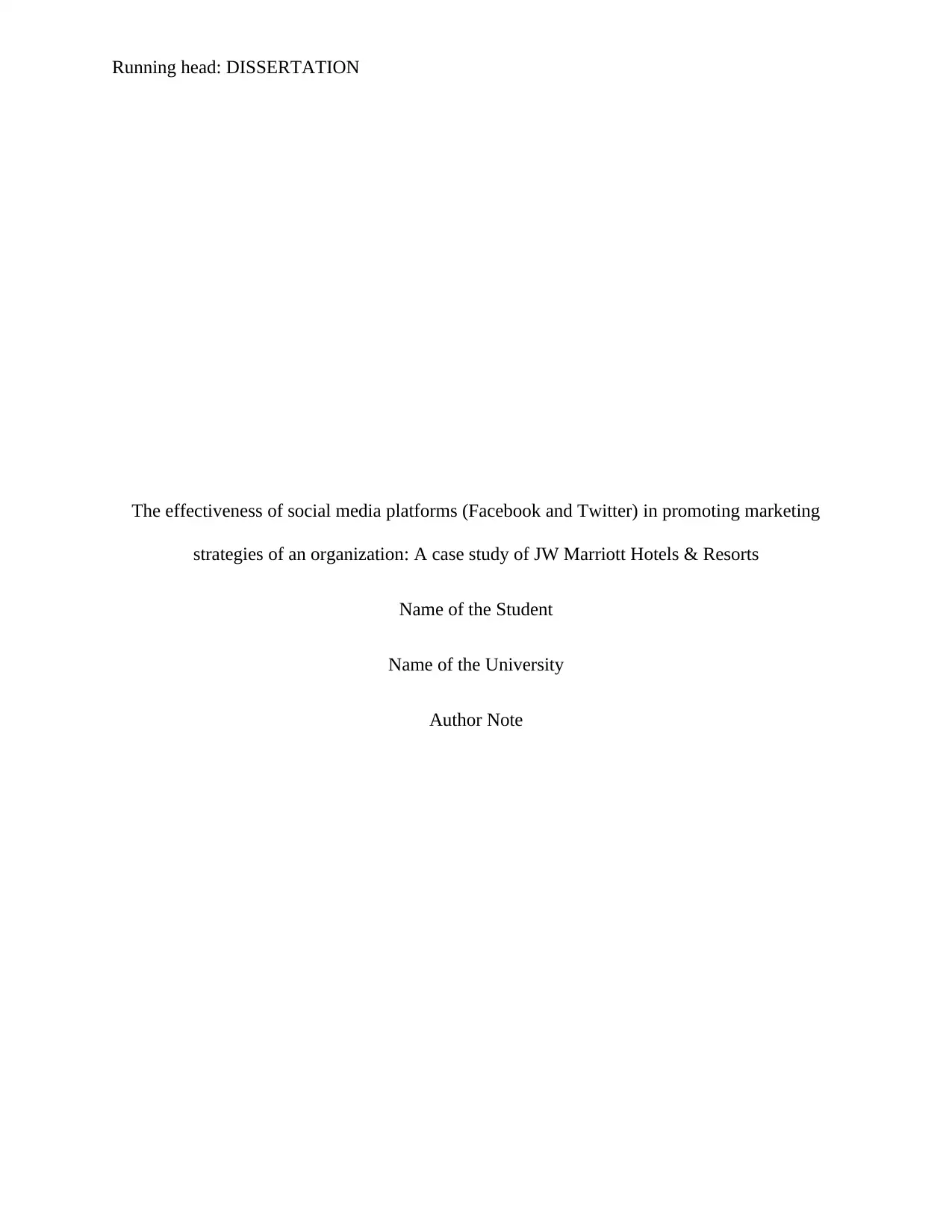
Running head: DISSERTATION
The effectiveness of social media platforms (Facebook and Twitter) in promoting marketing
strategies of an organization: A case study of JW Marriott Hotels & Resorts
Name of the Student
Name of the University
Author Note
The effectiveness of social media platforms (Facebook and Twitter) in promoting marketing
strategies of an organization: A case study of JW Marriott Hotels & Resorts
Name of the Student
Name of the University
Author Note
Paraphrase This Document
Need a fresh take? Get an instant paraphrase of this document with our AI Paraphraser
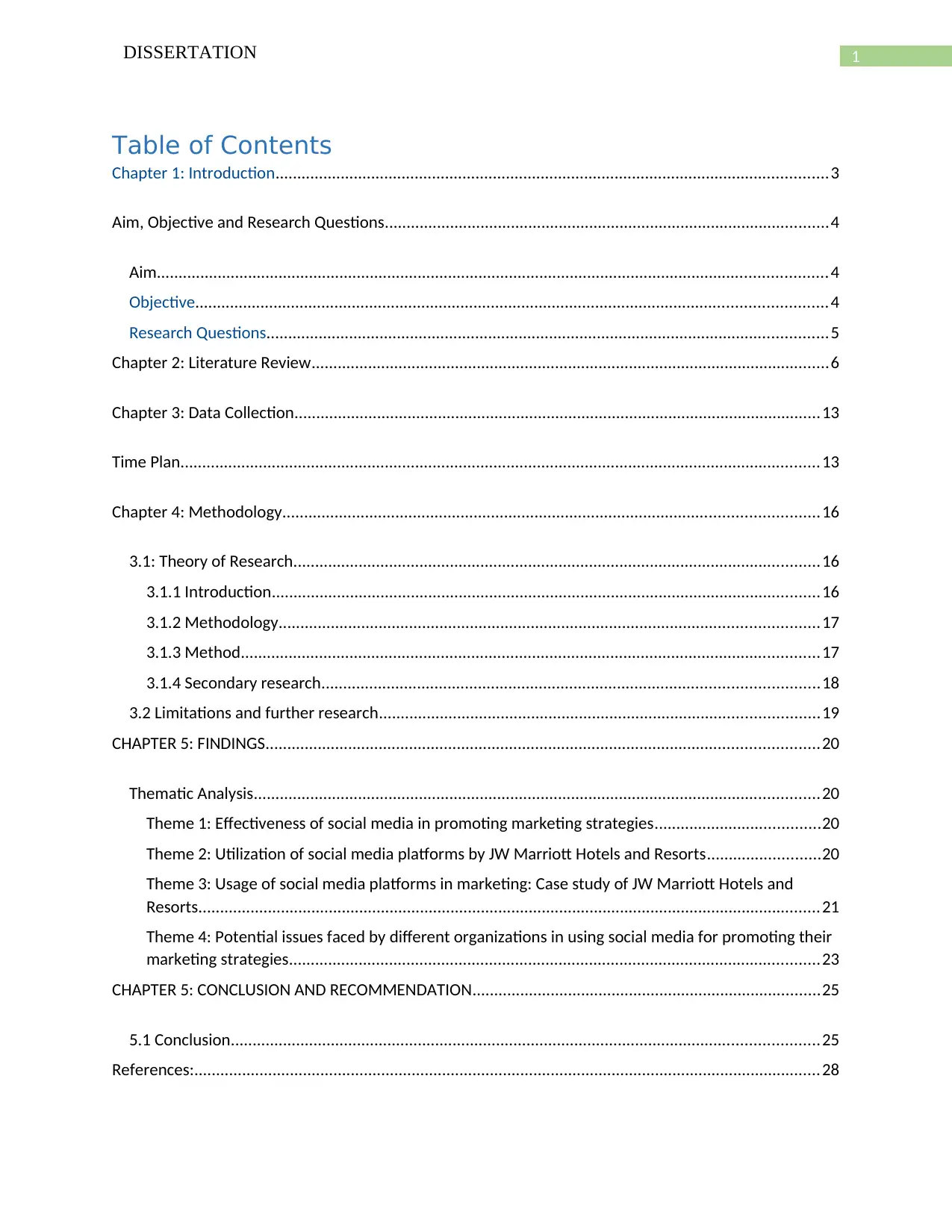
1DISSERTATION
Table of Contents
Chapter 1: Introduction...............................................................................................................................3
Aim, Objective and Research Questions......................................................................................................4
Aim..........................................................................................................................................................4
Objective.................................................................................................................................................4
Research Questions.................................................................................................................................5
Chapter 2: Literature Review.......................................................................................................................6
Chapter 3: Data Collection.........................................................................................................................13
Time Plan...................................................................................................................................................13
Chapter 4: Methodology...........................................................................................................................16
3.1: Theory of Research.........................................................................................................................16
3.1.1 Introduction..............................................................................................................................16
3.1.2 Methodology............................................................................................................................17
3.1.3 Method.....................................................................................................................................17
3.1.4 Secondary research..................................................................................................................18
3.2 Limitations and further research.....................................................................................................19
CHAPTER 5: FINDINGS...............................................................................................................................20
Thematic Analysis..................................................................................................................................20
Theme 1: Effectiveness of social media in promoting marketing strategies......................................20
Theme 2: Utilization of social media platforms by JW Marriott Hotels and Resorts..........................20
Theme 3: Usage of social media platforms in marketing: Case study of JW Marriott Hotels and
Resorts...............................................................................................................................................21
Theme 4: Potential issues faced by different organizations in using social media for promoting their
marketing strategies..........................................................................................................................23
CHAPTER 5: CONCLUSION AND RECOMMENDATION................................................................................25
5.1 Conclusion.......................................................................................................................................25
References:................................................................................................................................................28
Table of Contents
Chapter 1: Introduction...............................................................................................................................3
Aim, Objective and Research Questions......................................................................................................4
Aim..........................................................................................................................................................4
Objective.................................................................................................................................................4
Research Questions.................................................................................................................................5
Chapter 2: Literature Review.......................................................................................................................6
Chapter 3: Data Collection.........................................................................................................................13
Time Plan...................................................................................................................................................13
Chapter 4: Methodology...........................................................................................................................16
3.1: Theory of Research.........................................................................................................................16
3.1.1 Introduction..............................................................................................................................16
3.1.2 Methodology............................................................................................................................17
3.1.3 Method.....................................................................................................................................17
3.1.4 Secondary research..................................................................................................................18
3.2 Limitations and further research.....................................................................................................19
CHAPTER 5: FINDINGS...............................................................................................................................20
Thematic Analysis..................................................................................................................................20
Theme 1: Effectiveness of social media in promoting marketing strategies......................................20
Theme 2: Utilization of social media platforms by JW Marriott Hotels and Resorts..........................20
Theme 3: Usage of social media platforms in marketing: Case study of JW Marriott Hotels and
Resorts...............................................................................................................................................21
Theme 4: Potential issues faced by different organizations in using social media for promoting their
marketing strategies..........................................................................................................................23
CHAPTER 5: CONCLUSION AND RECOMMENDATION................................................................................25
5.1 Conclusion.......................................................................................................................................25
References:................................................................................................................................................28

2DISSERTATION
⊘ This is a preview!⊘
Do you want full access?
Subscribe today to unlock all pages.

Trusted by 1+ million students worldwide
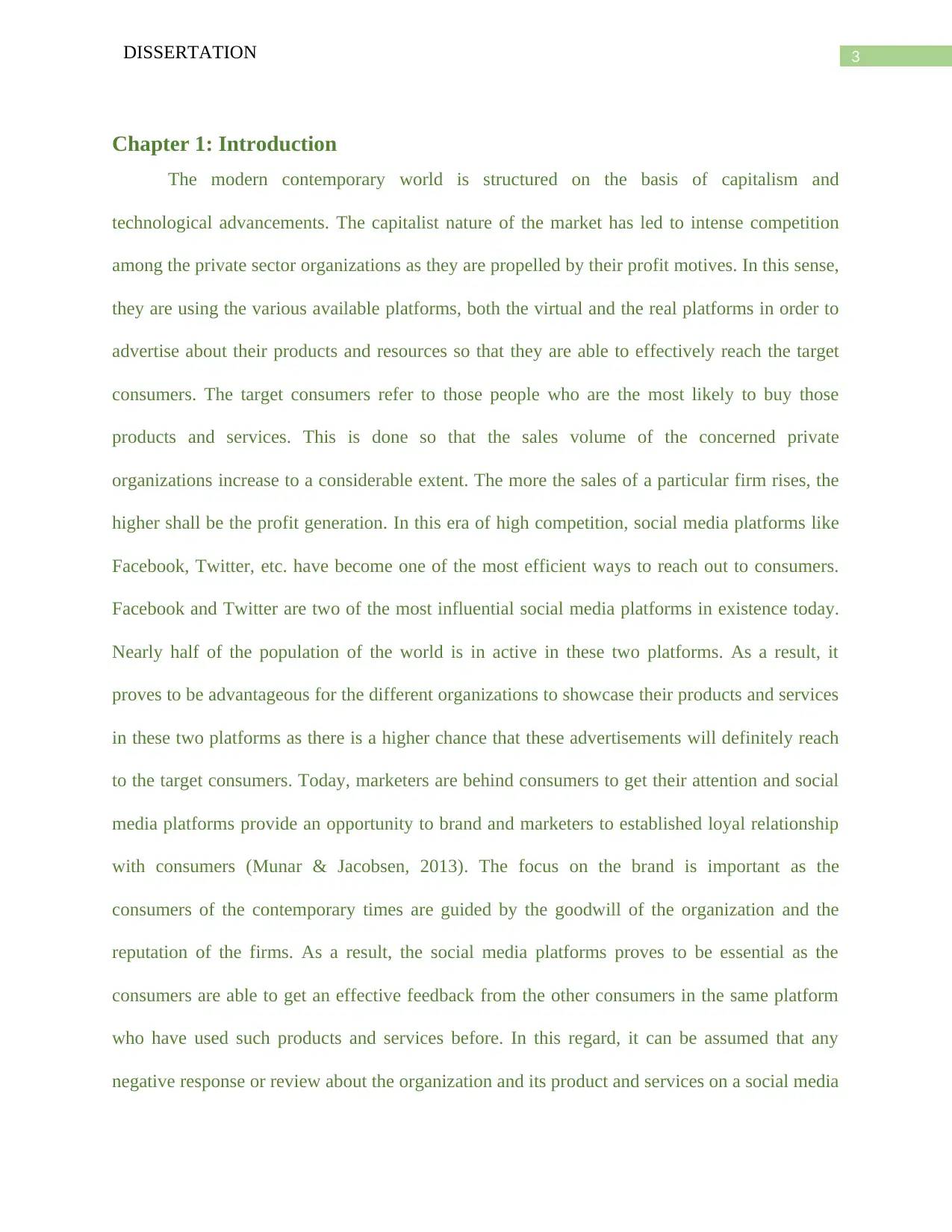
3DISSERTATION
Chapter 1: Introduction
The modern contemporary world is structured on the basis of capitalism and
technological advancements. The capitalist nature of the market has led to intense competition
among the private sector organizations as they are propelled by their profit motives. In this sense,
they are using the various available platforms, both the virtual and the real platforms in order to
advertise about their products and resources so that they are able to effectively reach the target
consumers. The target consumers refer to those people who are the most likely to buy those
products and services. This is done so that the sales volume of the concerned private
organizations increase to a considerable extent. The more the sales of a particular firm rises, the
higher shall be the profit generation. In this era of high competition, social media platforms like
Facebook, Twitter, etc. have become one of the most efficient ways to reach out to consumers.
Facebook and Twitter are two of the most influential social media platforms in existence today.
Nearly half of the population of the world is in active in these two platforms. As a result, it
proves to be advantageous for the different organizations to showcase their products and services
in these two platforms as there is a higher chance that these advertisements will definitely reach
to the target consumers. Today, marketers are behind consumers to get their attention and social
media platforms provide an opportunity to brand and marketers to established loyal relationship
with consumers (Munar & Jacobsen, 2013). The focus on the brand is important as the
consumers of the contemporary times are guided by the goodwill of the organization and the
reputation of the firms. As a result, the social media platforms proves to be essential as the
consumers are able to get an effective feedback from the other consumers in the same platform
who have used such products and services before. In this regard, it can be assumed that any
negative response or review about the organization and its product and services on a social media
Chapter 1: Introduction
The modern contemporary world is structured on the basis of capitalism and
technological advancements. The capitalist nature of the market has led to intense competition
among the private sector organizations as they are propelled by their profit motives. In this sense,
they are using the various available platforms, both the virtual and the real platforms in order to
advertise about their products and resources so that they are able to effectively reach the target
consumers. The target consumers refer to those people who are the most likely to buy those
products and services. This is done so that the sales volume of the concerned private
organizations increase to a considerable extent. The more the sales of a particular firm rises, the
higher shall be the profit generation. In this era of high competition, social media platforms like
Facebook, Twitter, etc. have become one of the most efficient ways to reach out to consumers.
Facebook and Twitter are two of the most influential social media platforms in existence today.
Nearly half of the population of the world is in active in these two platforms. As a result, it
proves to be advantageous for the different organizations to showcase their products and services
in these two platforms as there is a higher chance that these advertisements will definitely reach
to the target consumers. Today, marketers are behind consumers to get their attention and social
media platforms provide an opportunity to brand and marketers to established loyal relationship
with consumers (Munar & Jacobsen, 2013). The focus on the brand is important as the
consumers of the contemporary times are guided by the goodwill of the organization and the
reputation of the firms. As a result, the social media platforms proves to be essential as the
consumers are able to get an effective feedback from the other consumers in the same platform
who have used such products and services before. In this regard, it can be assumed that any
negative response or review about the organization and its product and services on a social media
Paraphrase This Document
Need a fresh take? Get an instant paraphrase of this document with our AI Paraphraser
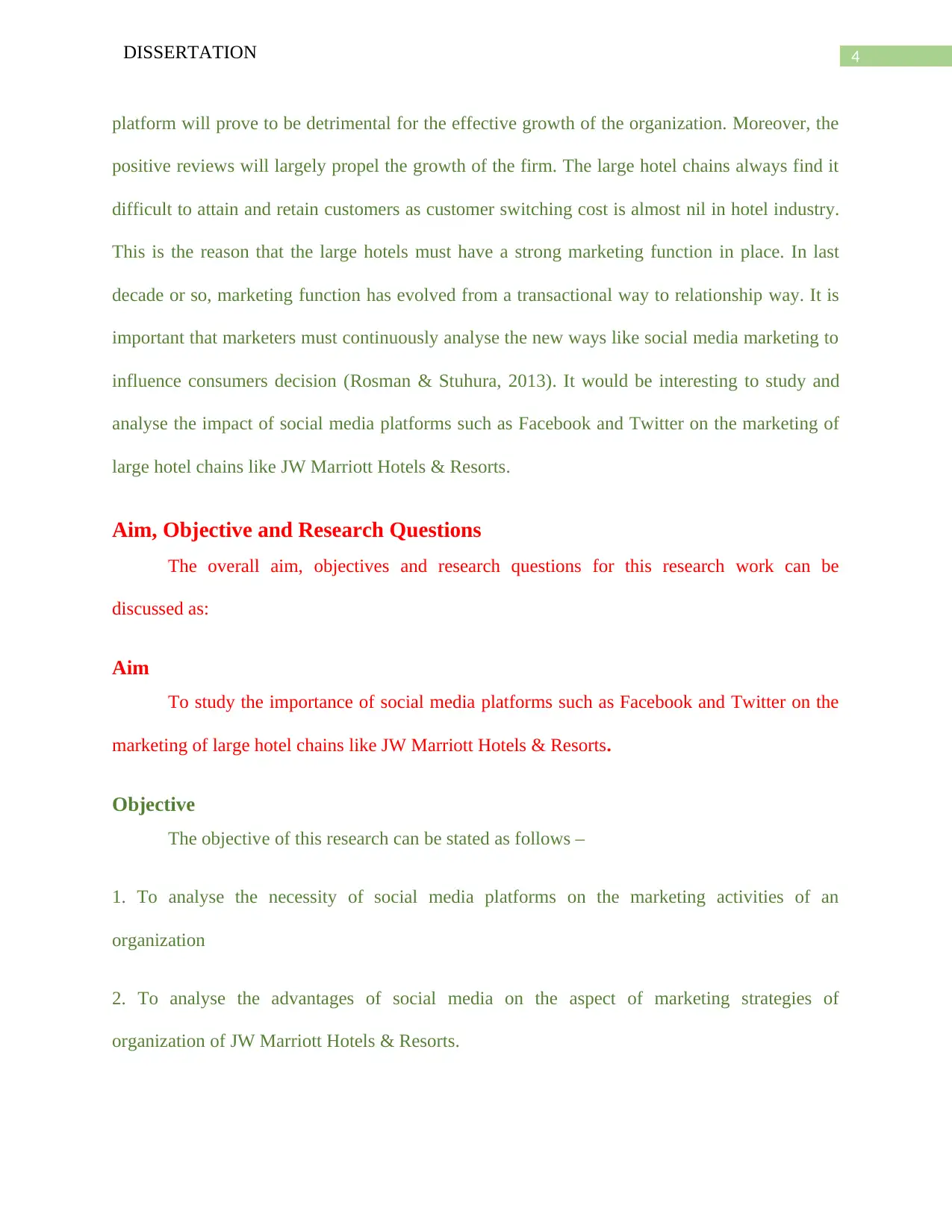
4DISSERTATION
platform will prove to be detrimental for the effective growth of the organization. Moreover, the
positive reviews will largely propel the growth of the firm. The large hotel chains always find it
difficult to attain and retain customers as customer switching cost is almost nil in hotel industry.
This is the reason that the large hotels must have a strong marketing function in place. In last
decade or so, marketing function has evolved from a transactional way to relationship way. It is
important that marketers must continuously analyse the new ways like social media marketing to
influence consumers decision (Rosman & Stuhura, 2013). It would be interesting to study and
analyse the impact of social media platforms such as Facebook and Twitter on the marketing of
large hotel chains like JW Marriott Hotels & Resorts.
Aim, Objective and Research Questions
The overall aim, objectives and research questions for this research work can be
discussed as:
Aim
To study the importance of social media platforms such as Facebook and Twitter on the
marketing of large hotel chains like JW Marriott Hotels & Resorts.
Objective
The objective of this research can be stated as follows –
1. To analyse the necessity of social media platforms on the marketing activities of an
organization
2. To analyse the advantages of social media on the aspect of marketing strategies of
organization of JW Marriott Hotels & Resorts.
platform will prove to be detrimental for the effective growth of the organization. Moreover, the
positive reviews will largely propel the growth of the firm. The large hotel chains always find it
difficult to attain and retain customers as customer switching cost is almost nil in hotel industry.
This is the reason that the large hotels must have a strong marketing function in place. In last
decade or so, marketing function has evolved from a transactional way to relationship way. It is
important that marketers must continuously analyse the new ways like social media marketing to
influence consumers decision (Rosman & Stuhura, 2013). It would be interesting to study and
analyse the impact of social media platforms such as Facebook and Twitter on the marketing of
large hotel chains like JW Marriott Hotels & Resorts.
Aim, Objective and Research Questions
The overall aim, objectives and research questions for this research work can be
discussed as:
Aim
To study the importance of social media platforms such as Facebook and Twitter on the
marketing of large hotel chains like JW Marriott Hotels & Resorts.
Objective
The objective of this research can be stated as follows –
1. To analyse the necessity of social media platforms on the marketing activities of an
organization
2. To analyse the advantages of social media on the aspect of marketing strategies of
organization of JW Marriott Hotels & Resorts.
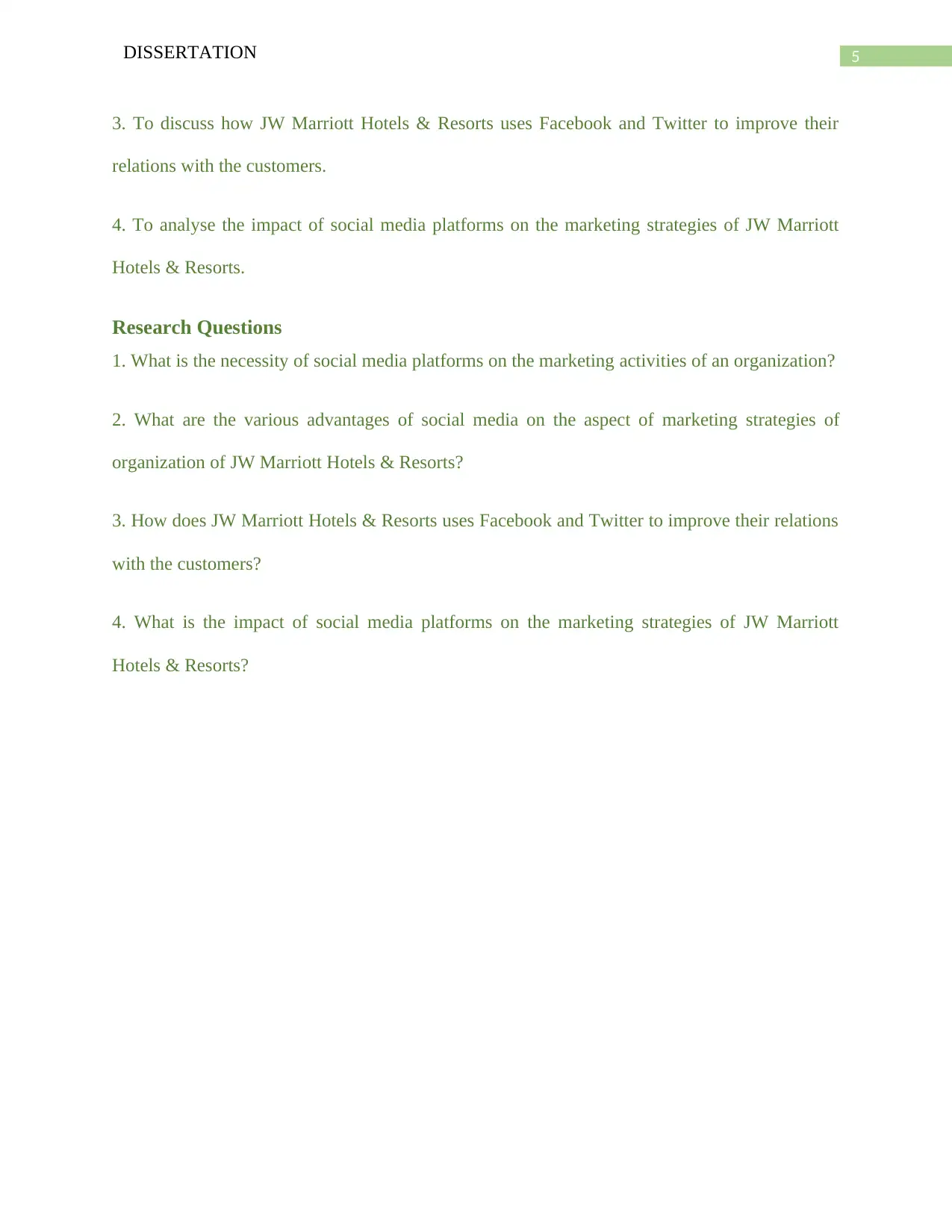
5DISSERTATION
3. To discuss how JW Marriott Hotels & Resorts uses Facebook and Twitter to improve their
relations with the customers.
4. To analyse the impact of social media platforms on the marketing strategies of JW Marriott
Hotels & Resorts.
Research Questions
1. What is the necessity of social media platforms on the marketing activities of an organization?
2. What are the various advantages of social media on the aspect of marketing strategies of
organization of JW Marriott Hotels & Resorts?
3. How does JW Marriott Hotels & Resorts uses Facebook and Twitter to improve their relations
with the customers?
4. What is the impact of social media platforms on the marketing strategies of JW Marriott
Hotels & Resorts?
3. To discuss how JW Marriott Hotels & Resorts uses Facebook and Twitter to improve their
relations with the customers.
4. To analyse the impact of social media platforms on the marketing strategies of JW Marriott
Hotels & Resorts.
Research Questions
1. What is the necessity of social media platforms on the marketing activities of an organization?
2. What are the various advantages of social media on the aspect of marketing strategies of
organization of JW Marriott Hotels & Resorts?
3. How does JW Marriott Hotels & Resorts uses Facebook and Twitter to improve their relations
with the customers?
4. What is the impact of social media platforms on the marketing strategies of JW Marriott
Hotels & Resorts?
⊘ This is a preview!⊘
Do you want full access?
Subscribe today to unlock all pages.

Trusted by 1+ million students worldwide
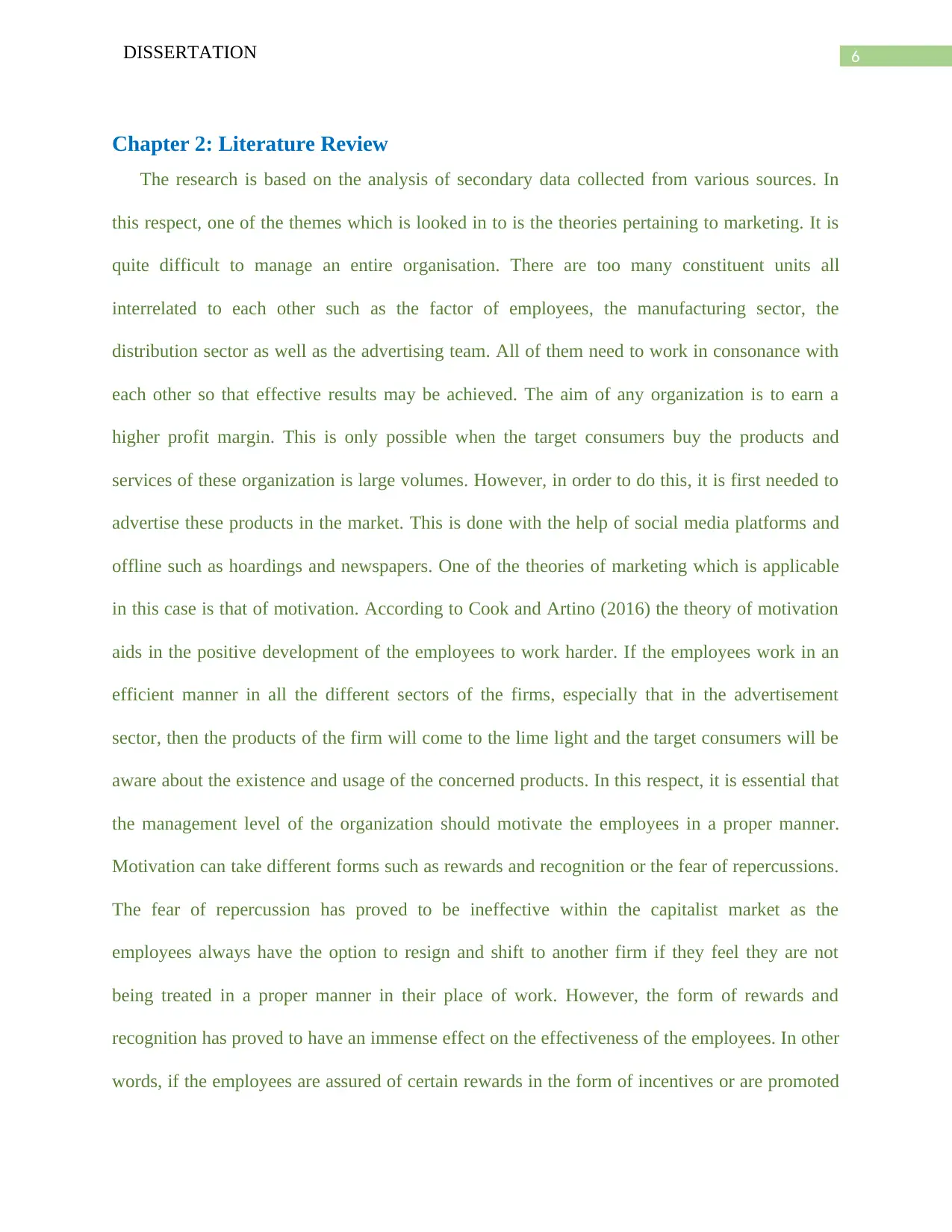
6DISSERTATION
Chapter 2: Literature Review
The research is based on the analysis of secondary data collected from various sources. In
this respect, one of the themes which is looked in to is the theories pertaining to marketing. It is
quite difficult to manage an entire organisation. There are too many constituent units all
interrelated to each other such as the factor of employees, the manufacturing sector, the
distribution sector as well as the advertising team. All of them need to work in consonance with
each other so that effective results may be achieved. The aim of any organization is to earn a
higher profit margin. This is only possible when the target consumers buy the products and
services of these organization is large volumes. However, in order to do this, it is first needed to
advertise these products in the market. This is done with the help of social media platforms and
offline such as hoardings and newspapers. One of the theories of marketing which is applicable
in this case is that of motivation. According to Cook and Artino (2016) the theory of motivation
aids in the positive development of the employees to work harder. If the employees work in an
efficient manner in all the different sectors of the firms, especially that in the advertisement
sector, then the products of the firm will come to the lime light and the target consumers will be
aware about the existence and usage of the concerned products. In this respect, it is essential that
the management level of the organization should motivate the employees in a proper manner.
Motivation can take different forms such as rewards and recognition or the fear of repercussions.
The fear of repercussion has proved to be ineffective within the capitalist market as the
employees always have the option to resign and shift to another firm if they feel they are not
being treated in a proper manner in their place of work. However, the form of rewards and
recognition has proved to have an immense effect on the effectiveness of the employees. In other
words, if the employees are assured of certain rewards in the form of incentives or are promoted
Chapter 2: Literature Review
The research is based on the analysis of secondary data collected from various sources. In
this respect, one of the themes which is looked in to is the theories pertaining to marketing. It is
quite difficult to manage an entire organisation. There are too many constituent units all
interrelated to each other such as the factor of employees, the manufacturing sector, the
distribution sector as well as the advertising team. All of them need to work in consonance with
each other so that effective results may be achieved. The aim of any organization is to earn a
higher profit margin. This is only possible when the target consumers buy the products and
services of these organization is large volumes. However, in order to do this, it is first needed to
advertise these products in the market. This is done with the help of social media platforms and
offline such as hoardings and newspapers. One of the theories of marketing which is applicable
in this case is that of motivation. According to Cook and Artino (2016) the theory of motivation
aids in the positive development of the employees to work harder. If the employees work in an
efficient manner in all the different sectors of the firms, especially that in the advertisement
sector, then the products of the firm will come to the lime light and the target consumers will be
aware about the existence and usage of the concerned products. In this respect, it is essential that
the management level of the organization should motivate the employees in a proper manner.
Motivation can take different forms such as rewards and recognition or the fear of repercussions.
The fear of repercussion has proved to be ineffective within the capitalist market as the
employees always have the option to resign and shift to another firm if they feel they are not
being treated in a proper manner in their place of work. However, the form of rewards and
recognition has proved to have an immense effect on the effectiveness of the employees. In other
words, if the employees are assured of certain rewards in the form of incentives or are promoted
Paraphrase This Document
Need a fresh take? Get an instant paraphrase of this document with our AI Paraphraser
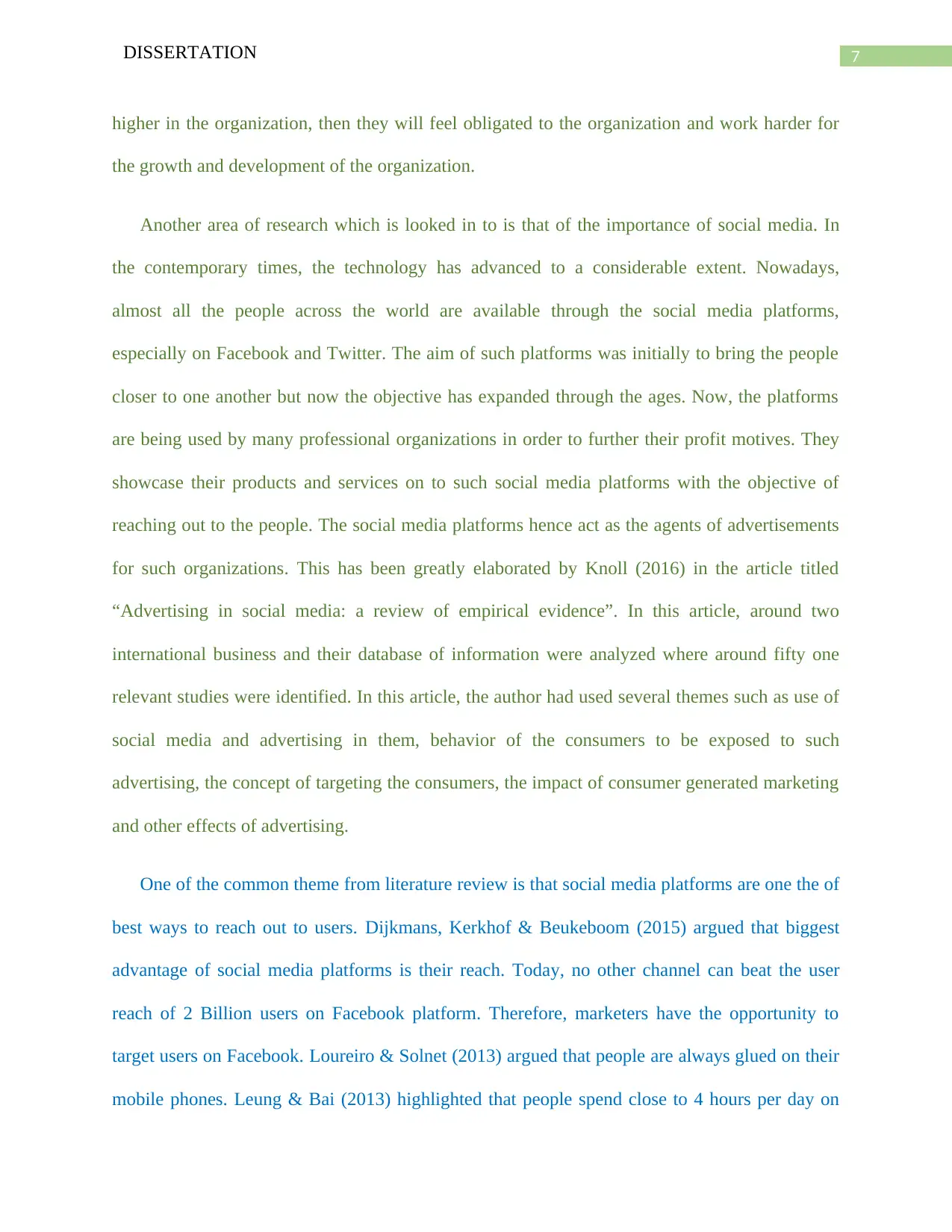
7DISSERTATION
higher in the organization, then they will feel obligated to the organization and work harder for
the growth and development of the organization.
Another area of research which is looked in to is that of the importance of social media. In
the contemporary times, the technology has advanced to a considerable extent. Nowadays,
almost all the people across the world are available through the social media platforms,
especially on Facebook and Twitter. The aim of such platforms was initially to bring the people
closer to one another but now the objective has expanded through the ages. Now, the platforms
are being used by many professional organizations in order to further their profit motives. They
showcase their products and services on to such social media platforms with the objective of
reaching out to the people. The social media platforms hence act as the agents of advertisements
for such organizations. This has been greatly elaborated by Knoll (2016) in the article titled
“Advertising in social media: a review of empirical evidence”. In this article, around two
international business and their database of information were analyzed where around fifty one
relevant studies were identified. In this article, the author had used several themes such as use of
social media and advertising in them, behavior of the consumers to be exposed to such
advertising, the concept of targeting the consumers, the impact of consumer generated marketing
and other effects of advertising.
One of the common theme from literature review is that social media platforms are one the of
best ways to reach out to users. Dijkmans, Kerkhof & Beukeboom (2015) argued that biggest
advantage of social media platforms is their reach. Today, no other channel can beat the user
reach of 2 Billion users on Facebook platform. Therefore, marketers have the opportunity to
target users on Facebook. Loureiro & Solnet (2013) argued that people are always glued on their
mobile phones. Leung & Bai (2013) highlighted that people spend close to 4 hours per day on
higher in the organization, then they will feel obligated to the organization and work harder for
the growth and development of the organization.
Another area of research which is looked in to is that of the importance of social media. In
the contemporary times, the technology has advanced to a considerable extent. Nowadays,
almost all the people across the world are available through the social media platforms,
especially on Facebook and Twitter. The aim of such platforms was initially to bring the people
closer to one another but now the objective has expanded through the ages. Now, the platforms
are being used by many professional organizations in order to further their profit motives. They
showcase their products and services on to such social media platforms with the objective of
reaching out to the people. The social media platforms hence act as the agents of advertisements
for such organizations. This has been greatly elaborated by Knoll (2016) in the article titled
“Advertising in social media: a review of empirical evidence”. In this article, around two
international business and their database of information were analyzed where around fifty one
relevant studies were identified. In this article, the author had used several themes such as use of
social media and advertising in them, behavior of the consumers to be exposed to such
advertising, the concept of targeting the consumers, the impact of consumer generated marketing
and other effects of advertising.
One of the common theme from literature review is that social media platforms are one the of
best ways to reach out to users. Dijkmans, Kerkhof & Beukeboom (2015) argued that biggest
advantage of social media platforms is their reach. Today, no other channel can beat the user
reach of 2 Billion users on Facebook platform. Therefore, marketers have the opportunity to
target users on Facebook. Loureiro & Solnet (2013) argued that people are always glued on their
mobile phones. Leung & Bai (2013) highlighted that people spend close to 4 hours per day on
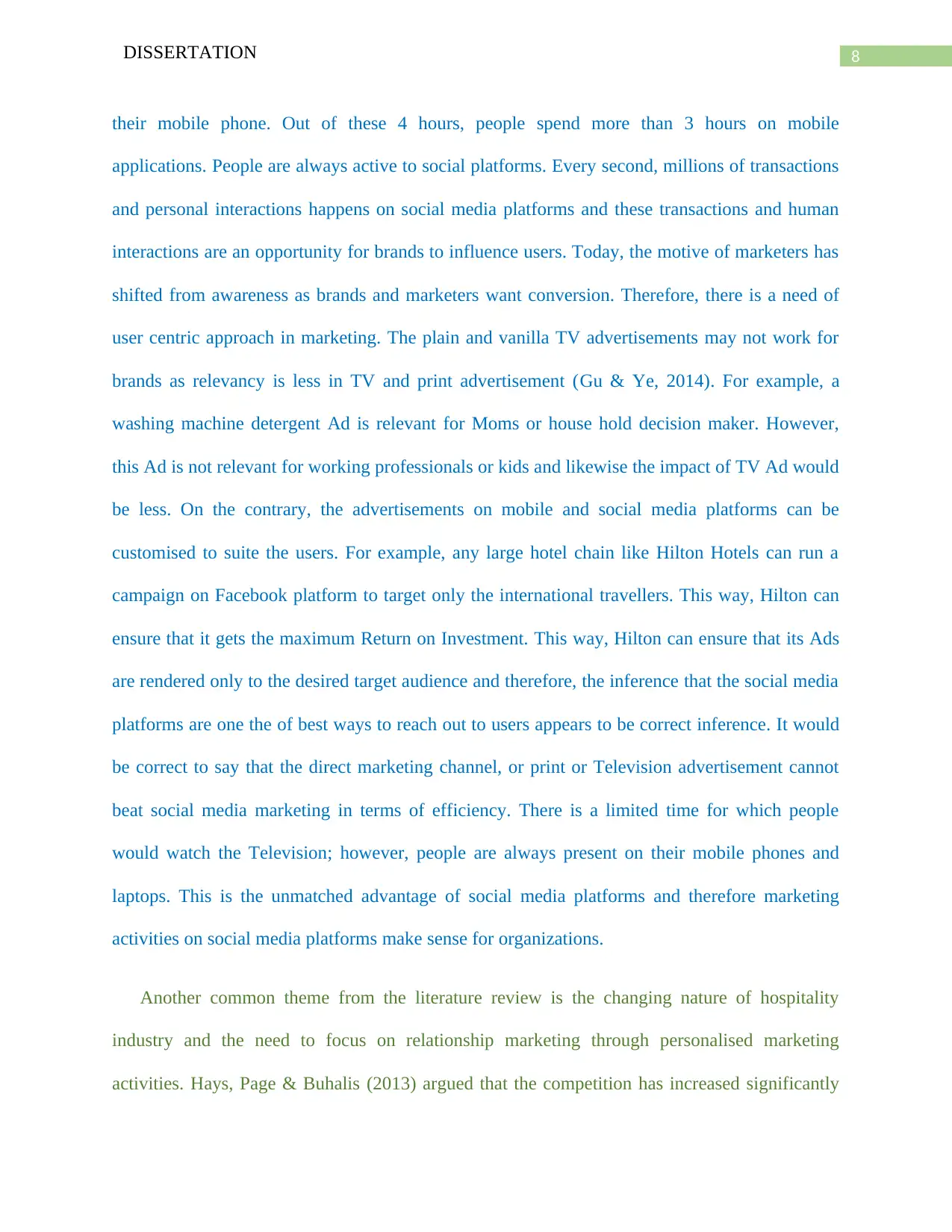
8DISSERTATION
their mobile phone. Out of these 4 hours, people spend more than 3 hours on mobile
applications. People are always active to social platforms. Every second, millions of transactions
and personal interactions happens on social media platforms and these transactions and human
interactions are an opportunity for brands to influence users. Today, the motive of marketers has
shifted from awareness as brands and marketers want conversion. Therefore, there is a need of
user centric approach in marketing. The plain and vanilla TV advertisements may not work for
brands as relevancy is less in TV and print advertisement (Gu & Ye, 2014). For example, a
washing machine detergent Ad is relevant for Moms or house hold decision maker. However,
this Ad is not relevant for working professionals or kids and likewise the impact of TV Ad would
be less. On the contrary, the advertisements on mobile and social media platforms can be
customised to suite the users. For example, any large hotel chain like Hilton Hotels can run a
campaign on Facebook platform to target only the international travellers. This way, Hilton can
ensure that it gets the maximum Return on Investment. This way, Hilton can ensure that its Ads
are rendered only to the desired target audience and therefore, the inference that the social media
platforms are one the of best ways to reach out to users appears to be correct inference. It would
be correct to say that the direct marketing channel, or print or Television advertisement cannot
beat social media marketing in terms of efficiency. There is a limited time for which people
would watch the Television; however, people are always present on their mobile phones and
laptops. This is the unmatched advantage of social media platforms and therefore marketing
activities on social media platforms make sense for organizations.
Another common theme from the literature review is the changing nature of hospitality
industry and the need to focus on relationship marketing through personalised marketing
activities. Hays, Page & Buhalis (2013) argued that the competition has increased significantly
their mobile phone. Out of these 4 hours, people spend more than 3 hours on mobile
applications. People are always active to social platforms. Every second, millions of transactions
and personal interactions happens on social media platforms and these transactions and human
interactions are an opportunity for brands to influence users. Today, the motive of marketers has
shifted from awareness as brands and marketers want conversion. Therefore, there is a need of
user centric approach in marketing. The plain and vanilla TV advertisements may not work for
brands as relevancy is less in TV and print advertisement (Gu & Ye, 2014). For example, a
washing machine detergent Ad is relevant for Moms or house hold decision maker. However,
this Ad is not relevant for working professionals or kids and likewise the impact of TV Ad would
be less. On the contrary, the advertisements on mobile and social media platforms can be
customised to suite the users. For example, any large hotel chain like Hilton Hotels can run a
campaign on Facebook platform to target only the international travellers. This way, Hilton can
ensure that it gets the maximum Return on Investment. This way, Hilton can ensure that its Ads
are rendered only to the desired target audience and therefore, the inference that the social media
platforms are one the of best ways to reach out to users appears to be correct inference. It would
be correct to say that the direct marketing channel, or print or Television advertisement cannot
beat social media marketing in terms of efficiency. There is a limited time for which people
would watch the Television; however, people are always present on their mobile phones and
laptops. This is the unmatched advantage of social media platforms and therefore marketing
activities on social media platforms make sense for organizations.
Another common theme from the literature review is the changing nature of hospitality
industry and the need to focus on relationship marketing through personalised marketing
activities. Hays, Page & Buhalis (2013) argued that the competition has increased significantly
⊘ This is a preview!⊘
Do you want full access?
Subscribe today to unlock all pages.

Trusted by 1+ million students worldwide
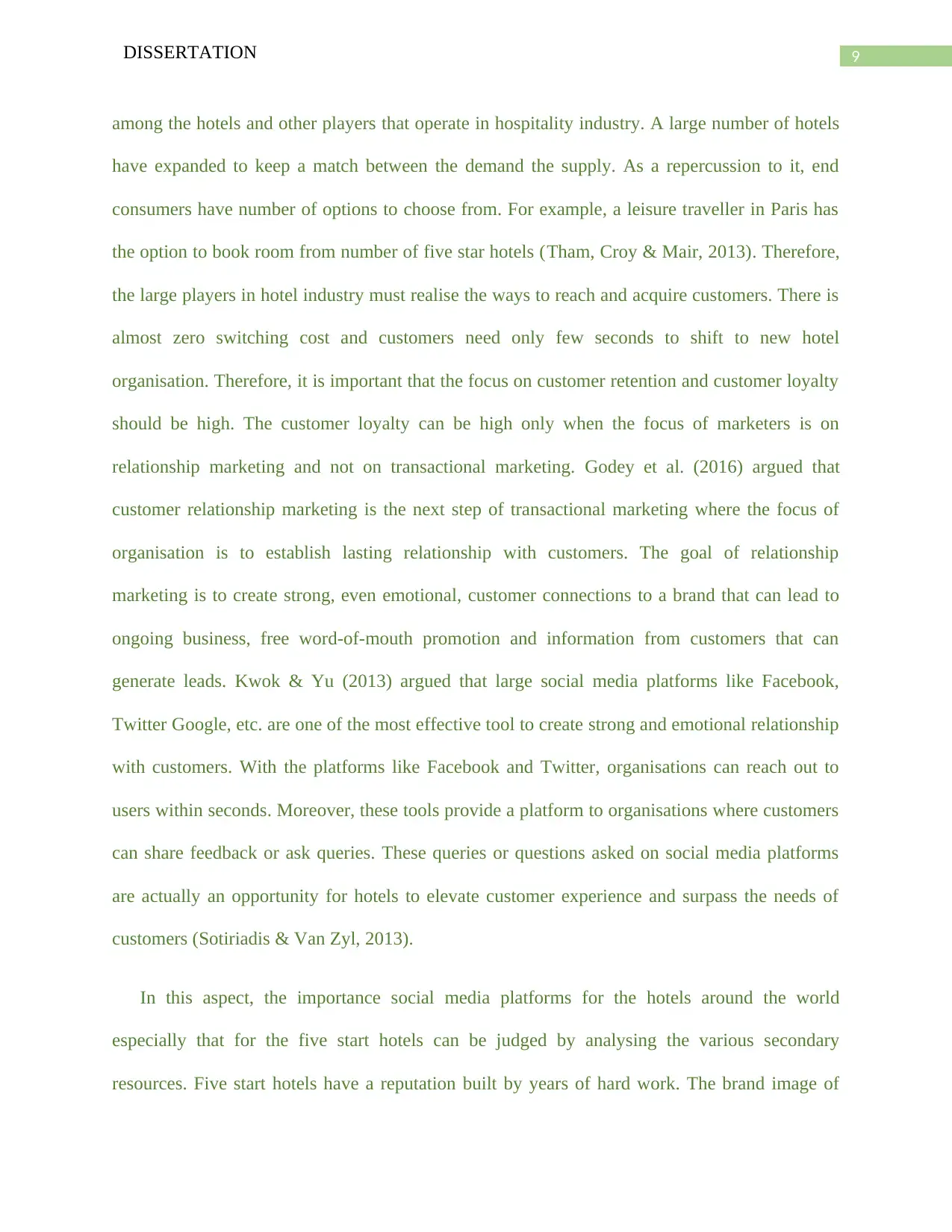
9DISSERTATION
among the hotels and other players that operate in hospitality industry. A large number of hotels
have expanded to keep a match between the demand the supply. As a repercussion to it, end
consumers have number of options to choose from. For example, a leisure traveller in Paris has
the option to book room from number of five star hotels (Tham, Croy & Mair, 2013). Therefore,
the large players in hotel industry must realise the ways to reach and acquire customers. There is
almost zero switching cost and customers need only few seconds to shift to new hotel
organisation. Therefore, it is important that the focus on customer retention and customer loyalty
should be high. The customer loyalty can be high only when the focus of marketers is on
relationship marketing and not on transactional marketing. Godey et al. (2016) argued that
customer relationship marketing is the next step of transactional marketing where the focus of
organisation is to establish lasting relationship with customers. The goal of relationship
marketing is to create strong, even emotional, customer connections to a brand that can lead to
ongoing business, free word-of-mouth promotion and information from customers that can
generate leads. Kwok & Yu (2013) argued that large social media platforms like Facebook,
Twitter Google, etc. are one of the most effective tool to create strong and emotional relationship
with customers. With the platforms like Facebook and Twitter, organisations can reach out to
users within seconds. Moreover, these tools provide a platform to organisations where customers
can share feedback or ask queries. These queries or questions asked on social media platforms
are actually an opportunity for hotels to elevate customer experience and surpass the needs of
customers (Sotiriadis & Van Zyl, 2013).
In this aspect, the importance social media platforms for the hotels around the world
especially that for the five start hotels can be judged by analysing the various secondary
resources. Five start hotels have a reputation built by years of hard work. The brand image of
among the hotels and other players that operate in hospitality industry. A large number of hotels
have expanded to keep a match between the demand the supply. As a repercussion to it, end
consumers have number of options to choose from. For example, a leisure traveller in Paris has
the option to book room from number of five star hotels (Tham, Croy & Mair, 2013). Therefore,
the large players in hotel industry must realise the ways to reach and acquire customers. There is
almost zero switching cost and customers need only few seconds to shift to new hotel
organisation. Therefore, it is important that the focus on customer retention and customer loyalty
should be high. The customer loyalty can be high only when the focus of marketers is on
relationship marketing and not on transactional marketing. Godey et al. (2016) argued that
customer relationship marketing is the next step of transactional marketing where the focus of
organisation is to establish lasting relationship with customers. The goal of relationship
marketing is to create strong, even emotional, customer connections to a brand that can lead to
ongoing business, free word-of-mouth promotion and information from customers that can
generate leads. Kwok & Yu (2013) argued that large social media platforms like Facebook,
Twitter Google, etc. are one of the most effective tool to create strong and emotional relationship
with customers. With the platforms like Facebook and Twitter, organisations can reach out to
users within seconds. Moreover, these tools provide a platform to organisations where customers
can share feedback or ask queries. These queries or questions asked on social media platforms
are actually an opportunity for hotels to elevate customer experience and surpass the needs of
customers (Sotiriadis & Van Zyl, 2013).
In this aspect, the importance social media platforms for the hotels around the world
especially that for the five start hotels can be judged by analysing the various secondary
resources. Five start hotels have a reputation built by years of hard work. The brand image of
Paraphrase This Document
Need a fresh take? Get an instant paraphrase of this document with our AI Paraphraser
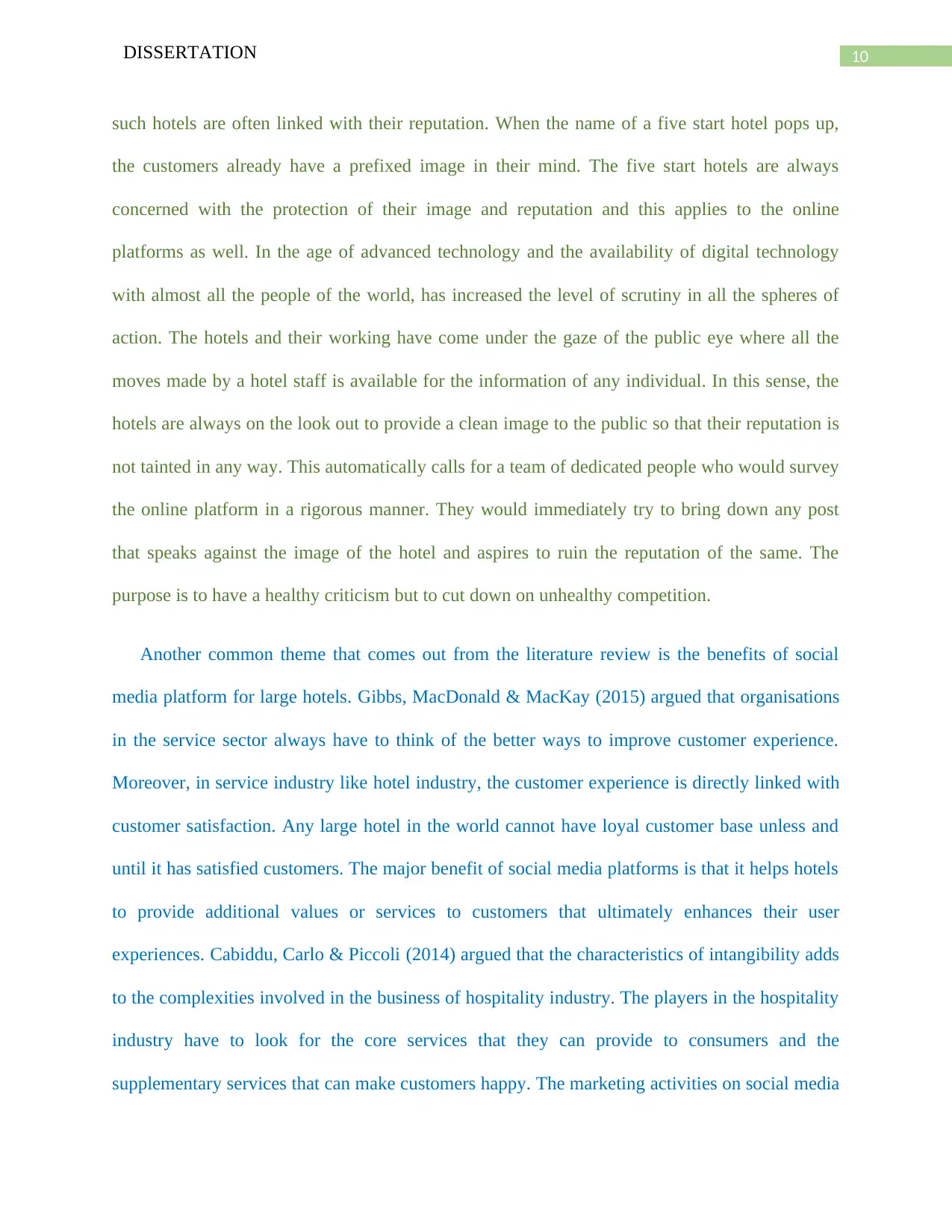
10DISSERTATION
such hotels are often linked with their reputation. When the name of a five start hotel pops up,
the customers already have a prefixed image in their mind. The five start hotels are always
concerned with the protection of their image and reputation and this applies to the online
platforms as well. In the age of advanced technology and the availability of digital technology
with almost all the people of the world, has increased the level of scrutiny in all the spheres of
action. The hotels and their working have come under the gaze of the public eye where all the
moves made by a hotel staff is available for the information of any individual. In this sense, the
hotels are always on the look out to provide a clean image to the public so that their reputation is
not tainted in any way. This automatically calls for a team of dedicated people who would survey
the online platform in a rigorous manner. They would immediately try to bring down any post
that speaks against the image of the hotel and aspires to ruin the reputation of the same. The
purpose is to have a healthy criticism but to cut down on unhealthy competition.
Another common theme that comes out from the literature review is the benefits of social
media platform for large hotels. Gibbs, MacDonald & MacKay (2015) argued that organisations
in the service sector always have to think of the better ways to improve customer experience.
Moreover, in service industry like hotel industry, the customer experience is directly linked with
customer satisfaction. Any large hotel in the world cannot have loyal customer base unless and
until it has satisfied customers. The major benefit of social media platforms is that it helps hotels
to provide additional values or services to customers that ultimately enhances their user
experiences. Cabiddu, Carlo & Piccoli (2014) argued that the characteristics of intangibility adds
to the complexities involved in the business of hospitality industry. The players in the hospitality
industry have to look for the core services that they can provide to consumers and the
supplementary services that can make customers happy. The marketing activities on social media
such hotels are often linked with their reputation. When the name of a five start hotel pops up,
the customers already have a prefixed image in their mind. The five start hotels are always
concerned with the protection of their image and reputation and this applies to the online
platforms as well. In the age of advanced technology and the availability of digital technology
with almost all the people of the world, has increased the level of scrutiny in all the spheres of
action. The hotels and their working have come under the gaze of the public eye where all the
moves made by a hotel staff is available for the information of any individual. In this sense, the
hotels are always on the look out to provide a clean image to the public so that their reputation is
not tainted in any way. This automatically calls for a team of dedicated people who would survey
the online platform in a rigorous manner. They would immediately try to bring down any post
that speaks against the image of the hotel and aspires to ruin the reputation of the same. The
purpose is to have a healthy criticism but to cut down on unhealthy competition.
Another common theme that comes out from the literature review is the benefits of social
media platform for large hotels. Gibbs, MacDonald & MacKay (2015) argued that organisations
in the service sector always have to think of the better ways to improve customer experience.
Moreover, in service industry like hotel industry, the customer experience is directly linked with
customer satisfaction. Any large hotel in the world cannot have loyal customer base unless and
until it has satisfied customers. The major benefit of social media platforms is that it helps hotels
to provide additional values or services to customers that ultimately enhances their user
experiences. Cabiddu, Carlo & Piccoli (2014) argued that the characteristics of intangibility adds
to the complexities involved in the business of hospitality industry. The players in the hospitality
industry have to look for the core services that they can provide to consumers and the
supplementary services that can make customers happy. The marketing activities on social media
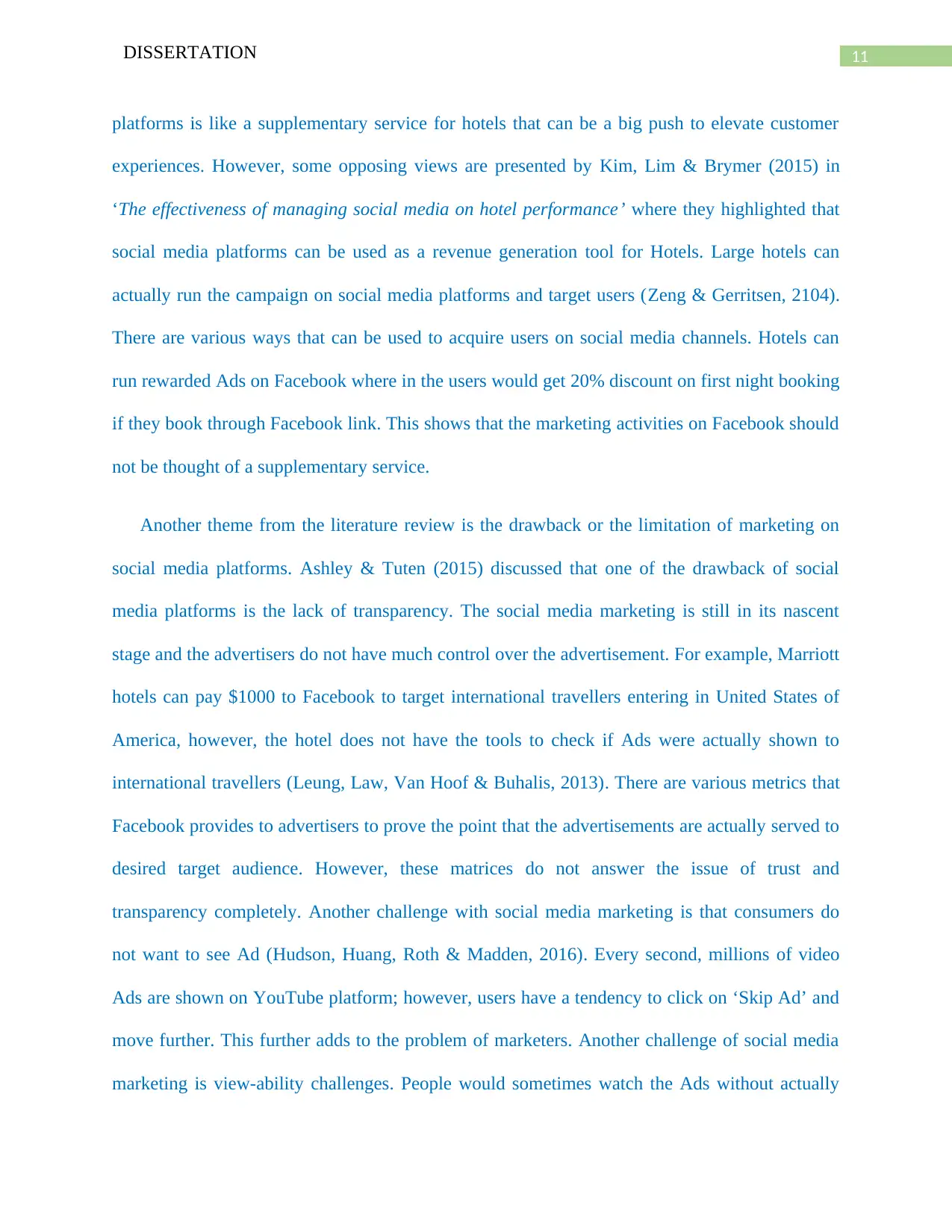
11DISSERTATION
platforms is like a supplementary service for hotels that can be a big push to elevate customer
experiences. However, some opposing views are presented by Kim, Lim & Brymer (2015) in
‘The effectiveness of managing social media on hotel performance’ where they highlighted that
social media platforms can be used as a revenue generation tool for Hotels. Large hotels can
actually run the campaign on social media platforms and target users (Zeng & Gerritsen, 2104).
There are various ways that can be used to acquire users on social media channels. Hotels can
run rewarded Ads on Facebook where in the users would get 20% discount on first night booking
if they book through Facebook link. This shows that the marketing activities on Facebook should
not be thought of a supplementary service.
Another theme from the literature review is the drawback or the limitation of marketing on
social media platforms. Ashley & Tuten (2015) discussed that one of the drawback of social
media platforms is the lack of transparency. The social media marketing is still in its nascent
stage and the advertisers do not have much control over the advertisement. For example, Marriott
hotels can pay $1000 to Facebook to target international travellers entering in United States of
America, however, the hotel does not have the tools to check if Ads were actually shown to
international travellers (Leung, Law, Van Hoof & Buhalis, 2013). There are various metrics that
Facebook provides to advertisers to prove the point that the advertisements are actually served to
desired target audience. However, these matrices do not answer the issue of trust and
transparency completely. Another challenge with social media marketing is that consumers do
not want to see Ad (Hudson, Huang, Roth & Madden, 2016). Every second, millions of video
Ads are shown on YouTube platform; however, users have a tendency to click on ‘Skip Ad’ and
move further. This further adds to the problem of marketers. Another challenge of social media
marketing is view-ability challenges. People would sometimes watch the Ads without actually
platforms is like a supplementary service for hotels that can be a big push to elevate customer
experiences. However, some opposing views are presented by Kim, Lim & Brymer (2015) in
‘The effectiveness of managing social media on hotel performance’ where they highlighted that
social media platforms can be used as a revenue generation tool for Hotels. Large hotels can
actually run the campaign on social media platforms and target users (Zeng & Gerritsen, 2104).
There are various ways that can be used to acquire users on social media channels. Hotels can
run rewarded Ads on Facebook where in the users would get 20% discount on first night booking
if they book through Facebook link. This shows that the marketing activities on Facebook should
not be thought of a supplementary service.
Another theme from the literature review is the drawback or the limitation of marketing on
social media platforms. Ashley & Tuten (2015) discussed that one of the drawback of social
media platforms is the lack of transparency. The social media marketing is still in its nascent
stage and the advertisers do not have much control over the advertisement. For example, Marriott
hotels can pay $1000 to Facebook to target international travellers entering in United States of
America, however, the hotel does not have the tools to check if Ads were actually shown to
international travellers (Leung, Law, Van Hoof & Buhalis, 2013). There are various metrics that
Facebook provides to advertisers to prove the point that the advertisements are actually served to
desired target audience. However, these matrices do not answer the issue of trust and
transparency completely. Another challenge with social media marketing is that consumers do
not want to see Ad (Hudson, Huang, Roth & Madden, 2016). Every second, millions of video
Ads are shown on YouTube platform; however, users have a tendency to click on ‘Skip Ad’ and
move further. This further adds to the problem of marketers. Another challenge of social media
marketing is view-ability challenges. People would sometimes watch the Ads without actually
⊘ This is a preview!⊘
Do you want full access?
Subscribe today to unlock all pages.

Trusted by 1+ million students worldwide
1 out of 36
Related Documents
Your All-in-One AI-Powered Toolkit for Academic Success.
+13062052269
info@desklib.com
Available 24*7 on WhatsApp / Email
![[object Object]](/_next/static/media/star-bottom.7253800d.svg)
Unlock your academic potential
Copyright © 2020–2025 A2Z Services. All Rights Reserved. Developed and managed by ZUCOL.




